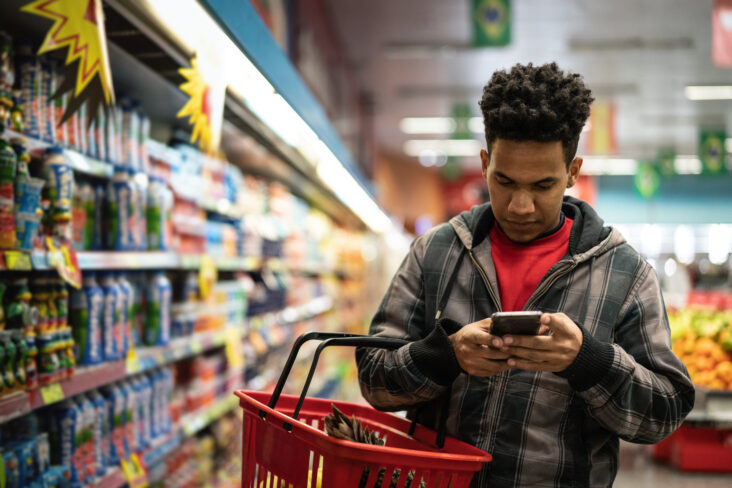In 2024, retailers and consumer packaged goods companies will need to be vigilant and nimble if they hope to capitalize on a more circumspect and inflation-weary population of U.S. shoppers.
They can expect consumers to be choosy and demand seamless shopping experiences that reflect who they are and how they shop. These shoppers will insist that the products they need be available and on-shelf when they need them. They’ll seek value, and they’ll be unafraid to switch brands in the name of a good deal. They’ll continue to migrate to private brands, and they’ll expect those brands to be of high quality and differentiated.
A dynamic and evolving consumer requires retailers and CPG companies to evolve along with them. Tried-and-true strategies like effective space and inventory management remain critical. But emerging technologies, particularly AI, are expected to play an outsized role in their success for 2024 and beyond.
Here are the key topics Advantage leaders expect to dominate the retail industry conversation this year:
Francesco Tinto, Chief Digital Officer
It’s all about seamless shopping experiences

Evolving technology — especially technology enabled by AI — will impact the retail space in the coming months.Technology will be enabling in two main areas. One, it will contribute to a seamless experience across different retail channels. More and more consumers want to have an experience that is seamless between the physical and digital store. Retailers want to make sure they’re present in each channel.
Two, a seamless shopping experience should also be personalized according to consumer attribution, preference and ways of interacting. Shoppers today are often bombarded by emails and discounts that are not relevant to their preferences or experiences. That creates a lot of spam in email or a lot of irrelevant banners on retail media.
For example, let’s say I have a chronic condition like diabetes. I shop in a drugstore. When I go for my prescription, I should be offered a potential complement of beneficial vitamins, and not — let’s say — a discount on candies that as a diabetic is probably not the best thing for me. Shoppers want to see content that is relevant to who they are and what they’re looking for. That is the consumer personalization needed, and it’s really important to use technology to serve the right content. AI will make a big difference.
Products must be on the shelves
In 2024, we expect an increased focus on shelf availability. That means retailers and CPG companies must focus on, ‘How do I make sure that our products really have good visibility? Do we know what is really available on the store shelf, so that as consumers start their experience in whatever channel, they know where a product is located?’ The worst thing is for a consumer to think a product is in the store and go there only to not be able to find it. Technology can help retailers have a real-time view of inventory within the store. Of course, it’s up to them to ensure that products are actually where they should be.
Second, retailers must ensure that pricing is dynamic based on demand and availability. It’s super important for retailers to be able to adjust price promotion markdowns depending on different events and to do it in real time. That will make them extremely competitive.
Michael Taylor, Chief Operating Officer — Retailer Services
Focus on inventory and space management

Minimizing out-of-stock inventory and managing active planograms across physical and digital shelves are critical requirements for retailers to maximize revenue and keep customers happy in 2024. While both endeavors require complex strategic and operational connectivity, the scope of these data sets makes shelf management an intriguing opportunity for AI activation to drive efficiencies and reduce errors.
For example, images of in-store assortments can now be quickly compared to planograms to identify variances, with a punch list of action items identified to reach full compliance. AI can also be used to flag inventory and pricing discrepancies — improving order management accuracy, cost savings and the customer experience. While any AI implementation requires a thorough plan and support, we expect this area to be one of many where retailers can activate technology to complement and improve upon their existing systems to drive growth.
Private brands will be hotter than ever
Private brands are on a strong growth trajectory. Our research shows that 44% of U.S. shoppers purchase more private brands today than they did a year ago. Another 34% of shoppers tell us they plan to continue increasing this behavior in 2024. Additionally, 92% of consumers trust private brands as much as or more than national brands, giving private brand programs permission to expand beyond traditional national brand equivalents into brands in their own right.
One innovation pillar within which we expect to see continued private brand product development is “purchasing with purpose.” Evolving plant-powered and sustainability expectations will continue to drive growth when focused to target specific consumer groups at a given retailer.
A second innovation pillar, “fit for functionality,” redefines customization, efficiency and simplicity to create multi-purposed private brand products that work both smarter and harder to meet a wide variety of needs.
Finally, the “uniquely for me” pillar showcases private brands’ opportunity to deliver immersive product experiences by innovating across sensory levers to drive engagement and share-worthy solutions in 2024. While private brands must continue to deliver on foundational expectations of quality and value, winning with innovation creates stronger programs and consumer loyalty — especially when supported with strong marketing and merchandising strategies to drive growth.
Jack Pestello, Chief Operating Officer — Branded Services
Consumers seek value in different shapes, forms and sizes

In 2024, CPG manufacturers and retailers must focus on value for consumers and create lots of avenues to do so. This could mean smaller sizes at lower price points, marketing the economic value of in-home vs. out-of-home, or offering larger products that have a more economical price per ounce or count, or deploy more and/or deeper discounts. That could mean discounting at 10% off vs. 2% off or $1 off vs. 2% off
or $1 off vs. 20-cents-off promotions, expanding private brands, offering more value-priced products or dedicating greater focus on economic meal options such as frozen pies vs. the fresh bakery or a pasta dish vs. a premium protein. There are many ways to meet consumers seeking value, and these need to be front and center to ensure that retailers get that shopping trip and manufacturers get their products into the consumers’ basket.
Shelves will be easier to shop in 2024
According to the Q3 2023 Advantage Outlook survey, more than 40% of retailers plan to reduce the number of products they carry, mostly to simplify their shelves. They’re also focused on fewer displays, especially in the corners of stores. This means that consumers can expect a more simplified shopping experience — from being able to find products, understand promotions and make decisions at shelf.
Beyond the top brands in each category and private brands, retailers will focus on a smaller set of brands or line extensions with a specialty nature — meaning the same product but a new flavor or size or color — and will look to make decisions on those products in line with specific segments of shoppers. This will give them the opportunity to cater to specific audiences by choosing the need states that best represent their customers and select products to align with those. For instance, they might choose to lean more heavily toward international products, health-awareness products or more organic or sustainable products based on the demographic information associated with specific store locations.
Andrea Young, Chief Operating Officer — Experiential Services
Expect consumers to continue switching up their brand preferences

Until there are meaningful declines in macroeconomic pressures, “everyday consumers” across the U.S. will continue to struggle to make ends meet and fall well short of accelerating any retirement plans. As a result, consumers will switch from prestige, premium, mass and “mass-tige” channels and seek out warehouse, direct-to-consumer and value channels and brands more than ever before.
As more consumer packaged goods companies combat their own profit and pricing pressures, the fight for promotion and marketing dollars figures to intensify.
Keep a close eye on insurgent brands
Insurgent brands will continue to play a meaningful role. While not every insurgent brand is a perfect success story, trends for the past three years demonstrate clearly that insurgent brands that find success grow faster than the categories they enter and sell at premium price points more often than national brands. In contrast to the dynamic of consumers trading down due to macro-economic pressures, insurgent brands will continue to command premium pricing.
Here’s why:
- They prioritize purpose- and mission-driven positioning to shape and tell their brand stories.
- Agile and asset-light go-to-market models allow brands to test, learn and succeed (or fail) fast with core consumers before scaling to meet logistical demands.
- They tap into key unmet needs around health, wellness, convenience and life-stage focused needs, among others.




